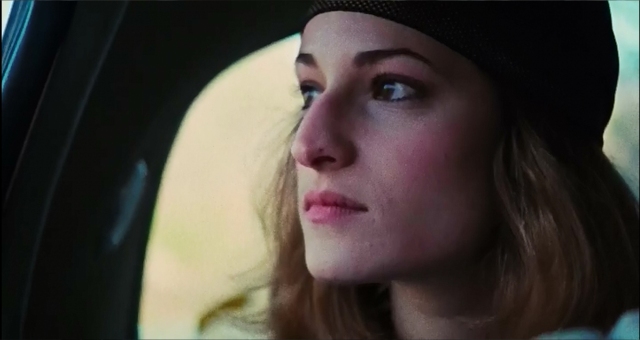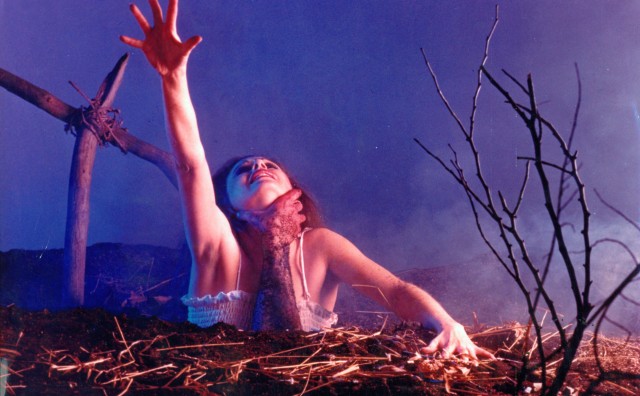THE EVIL DEAD (1981)
Bruce Campbell / Ellen Sandweiss / Richard DeManincor / Betsy Baker / Theresa Tilly / Ted Raimi / Special Effects Sam Raimi / Art Dept. Steve Frankel / Make-up Tom Sullivan / Original music Joseph LoDuca / Cinematography Tim Philo / Editing Edna Ruth Paul / Produced by Bruce Campbell / Written & Directed by Sam Raimi
The Ultimate Experience In Grueling Terror
The Evil Dead is set to return in a glossy, big budget remake, but already the fans of the original ‘experience in grueling terror’, are shifting uncomfortably in their prospective cinema seats. Sam Raimi may have come under some joking stick from his fan purists for that trilogy of Spiderman popcorn movies, and the forthcoming shiny-mainstream ‘Oz, the Great and Powerful‘.. but allowing the desecration of his sacred Evil Dead series with a remake injected with oodles of cash, just seems downright wrong on all levels. The Raimi darkly comic style has indeed lent itself very well to projects beyond the Evil Dead of course, most notably with the Sharon Stone western ‘The Quick and the Dead‘ in 1995, ‘The Gift‘ with it’s reluctant Psychic Cate Blanchett, and most recently with the wonderfully creepy ‘Drag me to Hell‘ (with a deliciously quirky performance from Alison Lohman).. but, nothing can quite top the genius originality of all three original Evil Dead films.
The Evil Dead achieves that clever reinterpretation of early cinema standards that characterises avant guard filmmaking so well. Taking us on a Phantom train ride, that early Silents such as the Lumière brothers film L’Arrivée d’un Train (1896) shocked audiences with, and transposing the scene to a loose scrub track through a dense woodland, arriving at what seems to be an end of the line eerie cabin final destination. The effect is amplified by a preamble trip across a rickety bridge track that threatens collapse, and establishes in our minds that this is indeed a one way trip.
The original Phantom Rides ran in two directions – the first, from the perspective of the train itself, was achieved by strapping a camera to the front of the train, becoming as it were, the eyes of the rocketing beast. The reverse of the Phantom Ride was the illusion of collision, and was achieved by placing the camera at an angle on a train platform, filming directly into the oncoming behemoth. This last effect caused such shock to early film audiences, that many filmgoers leapt from their seats to avoid the oncoming metal monster. Raimi uses both of these effects in the Evil Dead films, and often back to back, to flip and distort vision.
Travelling on the ‘phantom ride’ in ‘Berlin: Symphony of a Great City (1927)
—–
Camera-run from Evil Dead II
—–
Meeting the ‘phantom ride’ in L’Arrivée d’un Train (1896)
Released the same year, Stanley Kubrick’s The Shining also made use of Phantom Rides, but famously developed the now ubiquitous Steady Cam to allow cameramen to run and chase an actor or an actor’s perspective with grace and relative ease. With it’s comparatively minuscule budget, The Evil Dead had to make use of camera’s strapped to planks of wood, and cameramen who were willing to risk life and limb for art. Both films may have used similar techniques, but the overall effects were polar opposites in terms of mood and more obviously in perspective. Whereas Kubrick achieved a balletic smoothness to his gliding camera through The Overlook Hotel and it’s snowbound maze, Raimi’s looser and haphazard camera churns and warps vision, with the sickening buoyancy of a drug trip on a full stomach.
Evil Dead is pretty much exclusively shot in the third person, from the perspective of either it’s characters or from without, via some unseen embodiment of the dark woods. Vision plows forwards, backwards, or is knocked cockeyed into Dutch angles, transporting us into a bold melding of German Expressionism (tones of ‘The Cabinet of Doctor Caligari’ abound), and dizzying 60’s Batman style fight scenes.. like Hitchcock on acid. Raimi references other horror films of the 1970’s, such as ‘The Exorcist’, and ‘The Texas Chainsaw Massacre’, but unlike Tarantino, he reinterprets and explores these motifs, rather than as a direct homage. We get the feeling of The Evil Dead as an original setter of a new style, as opposed to the sort of ‘ticking-off list’ of reference points that later horror pieces like ‘Scream’ developed. In this sense, ‘The Evil Dead’ was as influential on the medium as ‘Psycho’, ‘Les Diaboliques’ and ‘Night of the Living Dead’.
Sam Raimi described the shooting process of Evil Dead as ‘twelve weeks of mirthless exercise in agony..’, a feeling echoed by it’s shell-shocked cast trapped on-location (Bruce Campbell, Ellen Sandweiss, Richard DeManincor, Betsy Baker & Theresa Tilly). Indeed, despite the film’s success, only Bruce Campbell reprising his role for parts II and III, with the actress Betsy Baker though key to the plot, having to morph into Denise Bixler and then Bridget Fonda as the trilogy advances. This change though works particularly well, since the whole feel of the Evil Dead trilogy is one of an almost dreamlike reinterpretation with each subsequent sequel. Before part one was set into production, Raimi had already attempted a dry-run short three years earlier, entitled ‘Within the Woods’, with Bruce Campbell and Ellen Sandweiss already on-board (good luck finding a decent copy to watch, by the way.. the only version I could track down online looked like it had been dragged through a hedge backwards), and exists as a fascinating prototype in embryonic form.
Raimi’s use of Shemp’s during all three films to make up for low budget and filming difficulties has become the stuff of legend and self parody, using not only himself, but also his brother Ted Raimi to double for the actors left, right and centre. A fake Shemp, for those not in the know, is when someone appears as a replacement for a missing actor during filming, and can be disguised by either not appearing fully in frame, or by standing with back to camera. The term ‘Shemp’ itself derives from Shemp Howard, of The Three Stooges, who having unfortunately died midway through filming, the Stooges decided to use Joe Palma (Shemp’s stand-in) along with old unused footage to create the illusion that Shemp was still around for the remaining contracted films in production. Each of the Evil Dead films supplies a long list of Shemps in their closing credits, and include numerous appearances by Raimi himself.
The Evil Dead joined the fraternity of hip, dangerous films that carried the infamous X -Certificate. As critic William Rotsler so succinctly put it – “The XXX-rating means hard-core, the XX-rating is for simulation, and an X-rating is for comparatively cool films.” For while it is true that Evil Dead became uncomfortable bedfellow with such nasties as ‘I Spit on your Grave’, and ‘Cannibal Holocaust’, it also rubbed shoulders with other heavy weight creative forces, such as ‘Fritz the Cat’, ‘A Clockwork Orange’, ‘Last Tango in Paris’, and the iconic ‘Midnight Cowboy’. The later years of the X-Certificate found the more dubious filmmakers applying the X to their films themselves, in hopes of gaining artificial notoriety. Ultimately the large number of seedy films carrying the X-Certificate began to cause some cinemas to avoid X films altogether, on the assumption that X just stood for Sex in the minds of patrons.. so by the time Evil Dead II was completed, Raimi decided, along with others to release their films unrated, dropping the X, and instead including a warning banner upfront – ‘Contains content for Adults Only’. By the early 90’s the X Certificate was put aside altogether, and replaced with a no-nonsense NC-17 rating in America, and 18 Certificate in Britain.
The enduring appeal of the ‘Dead’ films owes much to it’s highly inventive, offbeat humour, and it’s on the spot creativity. A joy and passion which can rarely be replicated on a big budget. The pleasures of stop-frame animation for example, an integral part of the final scenes of the 1st film, continued to appear in the subsequent sequels, so as to maintain a firm link to the creative magic of independent, low budget filmmaking, despite the increased budgets of those installments. Raimi struck gold with his Evil Dead series, and so too did it’s charismatic star, Bruce Campbell, who went on to become a highly successful cult personality in his own right, appearing in numerous roles and guest-spots in the years that followed, including an iconic run on cult Tv series ‘The Adventures of Brisco County, Jr.’ (well worth seeking out, though perhaps merely as an oddity in Tv land).
Something else I should mention.. that X-Cerificate still weaves it’s mystical power, and manages to scare off many a prospective viewer, who doubtless fear nightmares and revulsion.. which is a shame, since The Evil Dead is as fresh and original now as it’s ever been. Yes, there’s many a freaky, disturbing image to contend with, but on each occasion you experience a chill, you find a counterbalancing grin on your chops. ‘Evil Dead II: Dead before Dawn’, will have you laughing out loud, and by the time you reach the end of ‘Evil Dead III: Army of Darkness’, you’ll be pining for more, like a pathetic, Horror-sick puppy dog. As for those who continue to avoid the original, and instead get sucked into watching the remake instead? Well.. perhaps one of those nice, safe Twilight films will better suit you’s.
*
Within the Woods (1978)
The Evil Dead(1981/2)
The Evil Dead 2: Dead by Dawn (1987)
The Evil Dead 3: Army of Darkness (1992)
*
STILLS & POSTER ART
*
*















